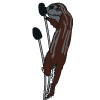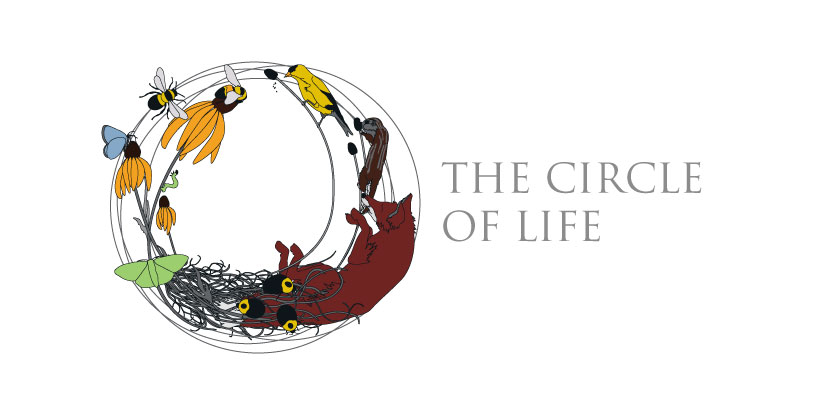THE FOUNDATION OF OUR ECOSYSTEM IS ROOTED IN NATIVE PLANTS.
BEE SUSTAINABLE. PLANT NATIVES.
Native plants have co-evolved with native insects and wildlife; they are deeply dependent on one another. Plants provide food and shelter to insects, birds and other small animals, which, in turn support larger predators. Native plants are fundamental stepping stones of a healthy ecosystem.
Introducing native plants to your garden or land can bring many seasons of delight and discovery. Their many merits, though, exceed their virtues of beauty, resilience and appeal to birds and pollinators.
![]() Clean Water: Because of the deep root system of most native plants, they act both as a sponge and filter. They help water soak down into the soil and filter out excess nutrients and pollutants, improving water quality.
Clean Water: Because of the deep root system of most native plants, they act both as a sponge and filter. They help water soak down into the soil and filter out excess nutrients and pollutants, improving water quality.
![]() Ecosystem Restoration:
Ecosystem Restoration:
Tallgrass prairies are North America’s most threatened major ecosystem, with about 99% plowed up or paved over since the 1830s. By planting native species, you are restoring ecosystems and preserving countless species that might otherwise be lost forever.
![]() Clean Air:
Clean Air:
Like forests, prairies and meadows sequester pollutants and carbon from the atmosphere. Even small plantings can help filter the air around your home, and large plantings can help to mitigate climate change.
![]() Resource Conservation:
Resource Conservation:
Once established, native plants can save you time and money because they require little or no irrigation, fertilizer, pruning or mowing.
![]() Invasive Species:
Invasive Species:
Outside of their native environments, some plants will aggressively out-compete others because they lack natural checks and balances like pests and predators. Some of our worst non-native invaders – Buckthorn, Honey-suckle, Dame’s Rocket, and Garlic Mustard – were first planted in gardens. By choosing natives, you can help prevent further habitat loss.
![]() Healthy Soil:
Healthy Soil:
The dance between native plants and animals created some of the most fertile soil on Earth, making the American Midwest the “Breadbasket to the World.” Native plants prevent soil erosion, create top soil and build fertility.
NATIVE FLORA BENEFITS NATIVE FAUNA
![]() Rusty Patched Bumblebee (Bombus affinis): The Rusty Patched Bumblebee is a federally-endangered species. This insect is one of the many on the brink of extinction. Worldwide, it is estimated we have lost 45% of invertebrates over the past 40 years.
Rusty Patched Bumblebee (Bombus affinis): The Rusty Patched Bumblebee is a federally-endangered species. This insect is one of the many on the brink of extinction. Worldwide, it is estimated we have lost 45% of invertebrates over the past 40 years.
![]() American Goldfinch (Spinus tristis): About 95% of all terrestrial birds feed their young insects. American Goldfinch babies eat many caterpillars before they leave the nest. Seeds are another important component of a bird’s diet. More than 300 trees, shrubs, and vines in North America have small fruits that depend on birds for seed dispersal.
American Goldfinch (Spinus tristis): About 95% of all terrestrial birds feed their young insects. American Goldfinch babies eat many caterpillars before they leave the nest. Seeds are another important component of a bird’s diet. More than 300 trees, shrubs, and vines in North America have small fruits that depend on birds for seed dispersal.
 Thirteen-lined ground Squirrel (Ictidomys tridecemlineatus): Prey animals like birds, small mammals, reptiles, and amphibians rely on insects and native plants as an important part of their diet. To protect themselves against predators, prey have developed a number of defense mechanisms. The unique markings on the Thirteen-lined Ground Squirrel help to keep it camouflaged, hidden in its environment.
Thirteen-lined ground Squirrel (Ictidomys tridecemlineatus): Prey animals like birds, small mammals, reptiles, and amphibians rely on insects and native plants as an important part of their diet. To protect themselves against predators, prey have developed a number of defense mechanisms. The unique markings on the Thirteen-lined Ground Squirrel help to keep it camouflaged, hidden in its environment.
 American Red Fox (Vulpes vulpes fulvus): Predators, like this American Red Fox, are an essential part of our ecosystem because they eat other animals, which sends a ripple effect through the food web called a “trophic cascade”. Because they eat other animals predators affect the populations of prey animals, which in turn affects plant populations.
American Red Fox (Vulpes vulpes fulvus): Predators, like this American Red Fox, are an essential part of our ecosystem because they eat other animals, which sends a ripple effect through the food web called a “trophic cascade”. Because they eat other animals predators affect the populations of prey animals, which in turn affects plant populations.
![]() American Carrion Beetle (Necrophila americana): Essential nutrient cycling is expected by fungus and scavenging insects like carrion beetles.
American Carrion Beetle (Necrophila americana): Essential nutrient cycling is expected by fungus and scavenging insects like carrion beetles.
A few square feet or several acres, we can all make a difference…
Hope grows in every backyard.
